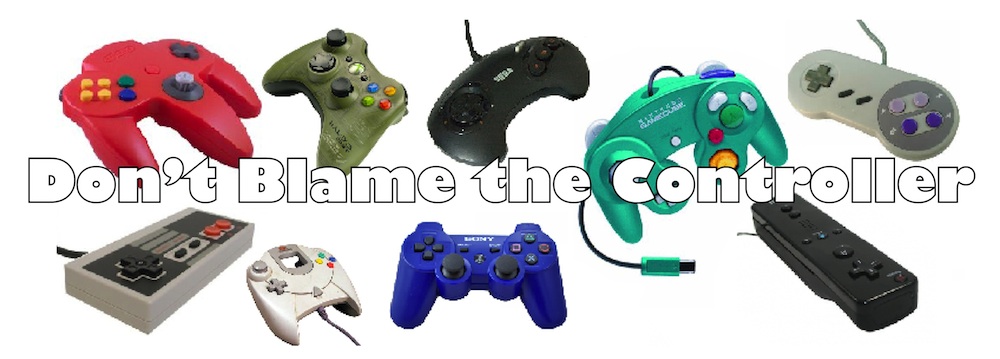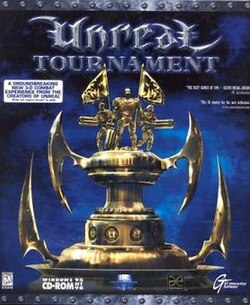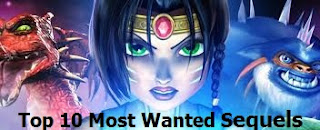A favorite pastime of video game writers is making lists of games that need sequels. It's a fun exercise to look back fondly on excellent games that ultimately hit dead ends, or were followed by dreary sequels that more or less destroyed the original game's mythology. It's becoming more and more difficult to make such lists because of the huge amount of sequels that are produced every year. If a game is a marginal hit, the odds are it will earn a sequel -- maybe an entire trilogy. DBtC contributor Rob joked that it would be easier to make a list of ten games that earned undeserved sequels. Maybe one day I'll make such a list, with his help of course.
In any event, please enjoy the following list. These are games -- some old, some relatively new -- that desperately need a sequel. In some cases the storyline is left unfinished; in other cases, the brilliant gameplay and interesting characters simply demand another game.
Without further ado: the Top 10 Games That Need Sequels.
10.
Kameo: Elements of Power (2005)
This was the first game I played for the Xbox 360. It was a launch title developed by Rare that was originally a Gamecube project before Microsoft stepped in and purchased Rare.
Kameo was, in general, well received by critics, although it didn't sell very well. The game wasn't a masterpiece by any means, but it looked gorgeous and it featured a lot of interesting mechanics, something that Rare could easily improve upon in a sequel.
 |
| The original Kameo (2005) |
Unfortunately, it appears that no sequel will ever be made.
Kameo 2 was actually in the works before Microsoft cancelled the project along with several others so it could assign Rare to produce software for Kinect. About 18 months ago, a former senior graphic engineer at Rare released some concept art for the now defunct
Kameo 2, and it's beautiful.
 |
| Concept art for Kameo 2. |
9.
Turok 3: Shadow of Oblivion (2000)
There have been a couple of
Turok games released after
Turok 3, but they range from mediocre to awful. That's not to say
Turok 3 was an excellent game -- it wasn't -- but it continued the story arc of the previous two
Turok games, which definitely were excellent. What is needed now is
Turok 4, a direct sequel to
Turok 3, totally unrelated to
Turok: Evolution (2002) the the reboot
Turok (2008).
The most recent game, Turok (2008), sold fairly well, so there remains some interest in the
Turok franchise. That's the good news. The bad news is that
Turok (2008) was published and distributed by Disney Interactive Stuidos, which in 2009 fired 70 people at Propaganda Games, the studio that developed the game and was planning a sequel. Oh, and Iguana Entertainment, the team that developed the first
Turok and
Turok 2, have gone bankrupt.
8.
Killer Instinct 2 (1996)
Most people probably know
Killer Instinct 2 as
Killer Instinct Gold, which arrived on the N64 shortly after launch in 1996. The game is a sequel to the arcade game
Killer Instinct, which was ported to the SNES. Unlike fighting games like
Street Fighter and
Mortal Kombat,
Killer Instinct focuses on combos and combo breakers. This won the game many admirers but also many detractors.

How likely is Killer Instinct 3? Somewhat likely, actually, thanks to some interesting news. In September it was reported that Microsoft had renewed the trademark for Killer Instinct. The trademark renewal has since hit a
speed bump, but the renewal application itself is reason for optimism. Still, I suspect it has more to do with Microsoft protecting its intellectual property and less to do with a proper sequel.
7.
Jade Empire (2005)
BioWare gets a lot of love for its
Mass Effect trilogy and for
Knights of the Old Republic, but not many people sing praises for
Jade Empire, an action RPG set in a fictional medieval Chinese kingdom. Yet the games deserves a sequel. And it need not be a direct sequel. The completely original universe that BioWare created in
Jade Empire is foundation enough. Add to that the innovative combat system and intuitive controls of the first game and
Jade Empire 2 would be glorious indeed.
A sequel is unlikely, however. BioWare community manager Chris Priestly said earlier this year that "currently we have no plans [to return to Jade Empire]." BioWare will probably devote most of its resources to
Mass Effect 4 and
Dragon Age 3.
6.
Tales of Symphonia (2004)
I know what you're thinking:
Tales of Symphonia already has a sequel, dummy! That's true, but what I want is a prequel to Namco's brilliant RPG. Anyone who has played and finished
Tales of Symphonia surely knows what story and which characters would feature in the prequel, but I dare not reveal any more for fear of spoilers. You'll just have to play the original to find out!
The odds of a prequel are insanely low, only because I doubt anyone at Namco has even considered the possibility of such a game. They have since moved on to new
Tales games, including a re-release of
Tales of the Abyss last year for 3DS.
5.
TimeSplitters: Future Perfect (2005)
In the space of five years, the world was treated to three
TimeSplitters games. In the past seven, it has seen none. For those who don't know, the
TimeSplitters games are often considered the spiritual successors to
GoldenEye 007 and
Perfect Dark, since Free Radical Design -- the company that made
TimeSplitters -- was made up of ex-Rare employees. In 2008, Free Radical went into administration, and the next year it was purchased by Crytek.
In 2011, a Crytek representative said that
TimeSplitters 4 was planned for next-generation consoles. But this June, Cevat Yerli from Crytek stated that "Look, I wish we were working on it. The thing with TimeSplitters is, if we made a sequel to TimeSplitters, nobody would accept this apart from some fans, and we don't know how big the fan community is unfortunately."
4.
Left 4 Dead 2 (2009)
Put together,
Left 4 Dead and
Left 4 Dead 2 have sold about 12 million copies worldwide. So you'd think a sequel would be a foregone conclusion, right? Not for Valve, which is a most beloved video game company that still draws the ire of fans when it comes to sequels. Two months ago, Chet Faliszek of Valve has this to say: "A 3? You know, some time down the road. Like anything, I would say that to all of our games. So that's not a promise of when or where."
Still, my hopes are high for
Left 4 Dead 3. The first two games in the series are two of the best cooperative video game experiences ever made. It was a great pleasure playing through the campaign with contributors (and great friends) Kevin, Nick, and Rob.
3.
Banjo-Tooie (2000)
So, this marks the third game on the list that involves Rare. Can you tell that I'm more than a little upset about their decline since 2002? During its N64 days Rare made many great titles, some of which used classic Nintendo characters, others that were entirely new IPs. One of the best and brightest of those new IPs was
Banjo-Kazooie, a brilliant platform game that rivaled
Super Mario 64 in terms of gameplay, depth, and variety. Two years later came
Banjo-Tooie, a sequel that some argue surpassed its predecessor. The ending of
Banjo-Tooie playfully teased a third entry, but nothing ever happened. Two games were released on the GBA -- a racing game and an interquel that bridged
Kazooie and
Tooie -- plus a new game on Xbox 360 with entirely new mechanics, but never a proper platforming sequel to
Tooie.
2.
Baldur's Gate: Dark Alliance II (2004)
Before August of this year, I would have said the likelihood of anyone ever playing
Baldur's Gate: Dark Alliance III was zero percent. But this summer Interplay resurrected Black Isle Studios -- the company responsible for the
Dark Alliance series -- eight years after shutting its doors and effectively cancelling the planned sequel. Now there is a sliver of hope.
Dark Alliance and its sequel are action RPGs set in the "Forgotten Realms" setting of
Dungeons & Dragons. The second
Dark Alliance game, which features five new characters, continues the story from the first game, and ends with a cliffhanger ending that suggests a third game is on the way. Maybe some day.
1.
Beyond Good & Evil (2003)
For nine years I've waited patiently for
Beyond Good & Evil 2, the sequel to one of the very best games of the past decade. I've been teased and taunted by concept art, rumors, and videos. There is even an
Amazon.com page for it, but of course there is nothing available to purchase. However, despite the years of waiting and frequent delays,
BG&E2 is probably the game on this list most likely to actually get made.
 |
| Beyond Good & Evil (2003) |
The game was first announced in 2008. It was due to be released on Xbox 360, and actually was a major factor in my decision to buy that system. Little did I know that the game would be postponed for so many months. In May of this year, Ubisoft designer Michel Ancel -- who created
Beyond Good & Evil -- said this: "We are in an active creation stage and at this moment we are only focusing on the game and making it the best game that we can." So that's somewhat good news. But just last month, Ubisoft CEO Yves Guillemot stated that:
"What's very important is that Michel Ancel is kind of doing too many things at the same time. He was working on Rayman Origins last year, and he's working a lot on Rayman Legends this year. So, you know, when he does that, he kind of puts too much of his time on the other projects that he has. So the fact is that working on Legends is slowing the process on Beyond Good & Evil 2."
So that's where we are now.
Rayman Legends is due for Wii U February 26, 2013. Maybe
Beyond Good & Evil 2 won't be far behind.





















































